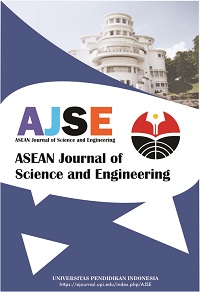How to Calculate Crystallite Size from X-Ray Diffraction (XRD) using Scherrer Method
Abstract
Keywords
Full Text:
PDFReferences
Alexander, L., and Klug, H. P. (1948). Basic aspects of X-ray absorption in quantitative diffraction analysis of powder mixtures. Analytical Chemistry, 20(10), 886-889.
Bunaciu, A. A., UdriŞTioiu, E. G., and Aboul-Enein, H. Y. (2015). X-ray diffraction: Instrumentation and applications. Critical Reviews in Analytical Chemistry, 45(4), 289-299.
Hakim, L., Dirgantara, M., and Nawir, M. (2019). Karakterisasi struktur material pasir bongkahan galian golongan c dengan menggunakan X-Ray Difraction (X-RD) di kota Palangkaraya. Jurnal Jejaring Matematika dan Sains, 1(1), 44-51.
Monshi, A., Foroughi, M. R., and Monshi, M. R. (2012). Modified Scherrer equation to estimate more accurately nano-crystallite size using XRD. World Journal of Nano Science and Engineering, 2(3), 154-160.
Nandiyanto, A. B. D., Oktiani, R., Ragadhita, R., Sukmafitri, A., and Zaen, R. (2020). Amorphous content on the photocatalytic performance of micrometer-sized tungsten trioxide particles. Arabian Journal of Chemistry, 13(1), 2912-2924.
Saini, I., Rozra, J., Chandak, N., Aggarwal, S., Sharma, P. K., and Sharma, A. (2013). Tailoring of electrical, optical and structural properties of PVA by addition of Ag nanoparticles. Materials Chemistry and Physics, 139(2-3), 802-810.
Smith, D. K., Johnson, G. G., Scheible, A., Wims, A. M., Johnson, J. L., and Ullmann, G. (1987). Quantitative X-ray powder diffraction method using the full diffraction pattern. Powder Diffraction, 2(2), 73-77.
Stobinski, L., Lesiak, B., Malolepszy, A., Mazurkiewicz, M., Mierzwa, B., Zemek, J., and Bieloshapka, I. (2014). Graphene oxide and reduced graphene oxide studied by the XRD, TEM and electron spectroscopy methods. Journal of Electron Spectroscopy and Related Phenomena, 195, 145-154.
Zhong, X. K., Li, D. C., and Jiang, J. G. (2009). Identification and quality control of Chinese medicine based on the fingerprint techniques. Current Medicinal Chemistry, 16(23), 3064-3075.
Zhou, X., Liu, D., Bu, H., Deng, L., Liu, H., Yuan, P., and Song, H. (2018). XRD-based quantitative analysis of clay minerals using reference intensity ratios, mineral intensity factors, Rietveld, and full pattern summation methods: A critical review. Solid Earth Sciences, 3(1), 16-29.
Zulkani Sinaga, Z. S., and Joni Warta, J. W. (2020). Analisis ukuran kristal dan sifat magnetik melalui proses pemesinan milling menggunakan metode karakterisasi Xrd, mechannical alloying, dan ultrasonik tekanan tinggi pada material barium hexaferrite (Bafe12o19). Jurnal Kajian Teknik Mesin (JKTM), 5(1), 1-6.
DOI: https://doi.org/10.17509/ajse.v2i1.37647
Refbacks
- There are currently no refbacks.
Copyright (c) 1970 Universitas Pendidikan Indonesia

This work is licensed under a Creative Commons Attribution-ShareAlike 4.0 International License.












